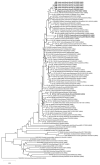Wild Bird Surveillance in the Gauteng Province of South Africa during the High-Risk Period for Highly Pathogenic Avian Influenza Virus Introduction
- PMID: 36146838
- PMCID: PMC9504564
- DOI: 10.3390/v14092027
Wild Bird Surveillance in the Gauteng Province of South Africa during the High-Risk Period for Highly Pathogenic Avian Influenza Virus Introduction
Abstract
Migratory birds carried clade 2.3.4.4B H5Nx highly pathogenic avian influenza (HPAI) viruses to South Africa in 2017, 2018 and 2021, where the Gauteng Province is a high-risk zone for virus introduction. Here, we combined environmental faecal sampling with sensitive rRT-PCR methods and direct Ion Torrent sequencing to survey wild populations between February and May 2022. An overall IAV incidence of 42.92% (100/231) in water bird faecal swab pools or swabs from moribund or dead European White Storks (Ciconia ciconia) was detected. In total, 7% of the IAV-positive pools tested H5-positive, with clade 2.3.4.4B H5N1 HPAI confirmed in the storks; 10% of the IAV-positive samples were identified as H9N2, and five complete H9N2 genomes were phylogenetically closely related to a local 2021 wild duck H9N2 virus, recent Eurasian LPAI viruses or those detected in commercial ostriches in the Western and Eastern Cape Provinces since 2018. H3N1, H4N2, H5N2 and H8Nx subtypes were also identified. Targeted surveillance of wild birds using environmental faecal sampling can thus be effectively applied under sub-Saharan African conditions, but region-specific studies should first be used to identify peak prevalence times which, in southern Africa, is linked to the peak rainfall period, when ducks are reproductively active.
Keywords: H5N1; H9N2; avian influenza; environmental faecal sampling; wild bird surveillance.
Conflict of interest statement
The authors declare no conflict of interest.
Figures



Similar articles
-
Spillover of an endemic avian Influenza H6N2 chicken lineage to ostriches and reassortment with clade 2.3.4.4b H5N1 high pathogenicity viruses in chickens.Vet Res Commun. 2024 Apr;48(2):1233-1237. doi: 10.1007/s11259-023-10258-z. Epub 2023 Nov 15. Vet Res Commun. 2024. PMID: 37966679 Free PMC article.
-
Highly Pathogenic and Low Pathogenic Avian Influenza H5 Subtype Viruses in Wild Birds in Ukraine.Avian Dis. 2019 Mar 1;63(sp1):235-245. doi: 10.1637/11880-042718.1. Avian Dis. 2019. PMID: 31713401
-
Highly Pathogenic and Low Pathogenic Avian Influenza H5 Subtype Viruses in Wild Birds in Ukraine.Avian Dis. 2019 Mar 1;63(sp1):219-229. doi: 10.1637/11879-042718-ResNote.1. Avian Dis. 2019. PMID: 31131580
-
Emergence of a new genotype of clade 2.3.4.4b H5N1 highly pathogenic avian influenza A viruses in Bangladesh.Emerg Microbes Infect. 2023 Dec;12(2):e2252510. doi: 10.1080/22221751.2023.2252510. Epub 2023 Aug 25. Emerg Microbes Infect. 2023. PMID: 37622753 Free PMC article.
-
The genetics of highly pathogenic avian influenza viruses of subtype H5 in Germany, 2006-2020.Transbound Emerg Dis. 2021 May;68(3):1136-1150. doi: 10.1111/tbed.13843. Epub 2020 Sep 29. Transbound Emerg Dis. 2021. PMID: 32964686 Review.
Cited by
-
High pathogenic avian influenza A(H5) viruses of clade 2.3.4.4b in Europe-Why trends of virus evolution are more difficult to predict.Virus Evol. 2024 Apr 6;10(1):veae027. doi: 10.1093/ve/veae027. eCollection 2024. Virus Evol. 2024. PMID: 38699215 Free PMC article.
-
Outbreaks of H5N1 High Pathogenicity Avian Influenza in South Africa in 2023 Were Caused by Two Distinct Sub-Genotypes of Clade 2.3.4.4b Viruses.Viruses. 2024 May 31;16(6):896. doi: 10.3390/v16060896. Viruses. 2024. PMID: 38932187 Free PMC article.
-
Stability of the Virucidal Activity of Commercial Disinfectants against Avian Influenza Viruses under Different Environmental Conditions.Pathogens. 2023 Nov 24;12(12):1382. doi: 10.3390/pathogens12121382. Pathogens. 2023. PMID: 38133267 Free PMC article.
-
Sequence-based epitope mapping of high pathogenicity avian influenza H5 clade 2.3.4.4b in Latin America.Front Vet Sci. 2024 Apr 29;11:1347509. doi: 10.3389/fvets.2024.1347509. eCollection 2024. Front Vet Sci. 2024. PMID: 38746927 Free PMC article.
-
Identification of B-Cell Epitopes Located on the Surface of the S1 Protein of Infectious Bronchitis Virus M41 Strains.Viruses. 2025 Mar 24;17(4):464. doi: 10.3390/v17040464. Viruses. 2025. PMID: 40284907 Free PMC article.
References
-
- Fusaro A., Zecchin B., Vrancken B., Abolnik C., Ademun R., Alassane A., Arafa A., Awuni J.A., Couacy-Hymann E., Coulibaly M.B., et al. Disentangling the role of Africa in the global spread of H5 highly pathogenic avian influenza. Nat. Commun. 2019;10:1–13. doi: 10.1038/s41467-019-13287-y. - DOI - PMC - PubMed
-
- Bonilla-Aldana D.K., Aguirre-Florez M., Villamizar-Pena R., Gutierrez-Ocampo E., Henao-Martinez J.F., Cvetkovic-Vega A., Dhama K., Rabaan A., Sah R., Rodriguez-Moralez A.J., et al. After SARS-CoV-2, will H5N6 and other influenza viruses follow the pandemic path? Inf. Med. 2020;28:475–485. - PubMed
-
- McCauley J.W., Hlongo S., Kaverin N.V., Kochs G., Lamb R.A., Matrosovich M.N. Release. Berlin, Germany. 2019. [(accessed on 1 July 2022)]. Available online: https://talk.ictvonline.org/ictv-reports/ictv_9th_report/negative-sense-....
Publication types
MeSH terms
Substances
LinkOut - more resources
Full Text Sources
Medical

